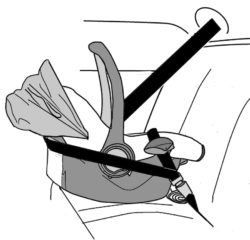NOTE: This article describes car seat brand/model usage, as of a certain date. Always check the product instructions that come with any given car seat.
Graco now allows the use of European belt routing (aka Euro-routing) for baseless installation of all SnugRide CRs with Click Connect (including all SnugLock models) in the U.S. and Canada. This permission is stated in the most recent instructions of most SnugRide models, but is also retroactively given on units of Click Connect SnugRides that do not state this permission in the instructions. (Go to the FAQ section at www.gracobaby.com and search Euro to find written permission from Graco.)
SnugRide models that may not be installed using Euro-routing in baseless mode are those called Classic Connect. Classic Connect models include, but are not limited to, all units with a 22-pound upper weight limit and many with a rear-adjust harness. According to Graco, Classic Connect models were discontinued in October 2017. Therefore, while fewer and fewer of these models will be in use going forward, be aware that there will be unexpired units in use until late 2024.
The Euro-routing method, as shown in the image above, involves routing the lap portion of a seat belt through the traditional belt path and then wrapping the shoulder portion behind the CR shell. (For routing on SnugRides, check instructions for any specified use of a guide on the CR shell. However, for most units—including any with retroactive permission—simply route the shoulder belt across the back of the CR, underneath the protruding part used to connect the CR to a stroller.)
While Euro-routing is not a typical installation method in the U.S. and Canada, it has become more common over the past several years. An SRN article five years ago described this installation method as emerging at the time, and even more CR models offer this option today. Today’s caregivers are likely to find the technique more useful than ever, given the rise in popularity of ride-sharing.
When permitted, Euro-routing is always optional, not required, as it does not work with all seat belt systems. (Although, see the next section for an installation tip that may help.) However, when allowed, manufacturers tend to encourage Euro-routing whenever possible. Having the shoulder belt wrapped behind the CR adds protection, as it supports the back of the CR, which limits forward rotation.
Finding Lap-Shoulder Belts to Be Too Short for Euro-Routing? Try This Tip
FMVSS 213 requires CRs to be tested while installed using a lap-only belt. Therefore, there is no required U.S. test to measure the effectiveness of installations using Euro-routing, since that technique involves a lap-shoulder belt. However, from experience in Europe and through voluntary testing, many manufacturers recognize the benefits of Euro-routing and choose to offer it as an option on CRs sold in North America.
If a lap-shoulder belt seems to be too short for Euro-routing, try this technique:
- Route the lap portion of the belt through the CR belt path guides (across the child’s leg area), but don’t buckle the belt.
- Wrap the shoulder portion of the belt around the back of the CR (following model-specific instructions, if any, for using a guide on the back of the CR shell).
- Buckle the belt, and then complete installation, as instructed, by setting the CR to the proper angle and tightening the belt.
By buckling the belt after the shoulder belt has been routed (not before), a belt that may seem to be too short for Euro-routing is often ample. This technique is also less likely to tempt the user to tilt the top of CR shell forward to enable shoulder belt placement (which can be awkward or even risky if a baby is seated in the CR).

